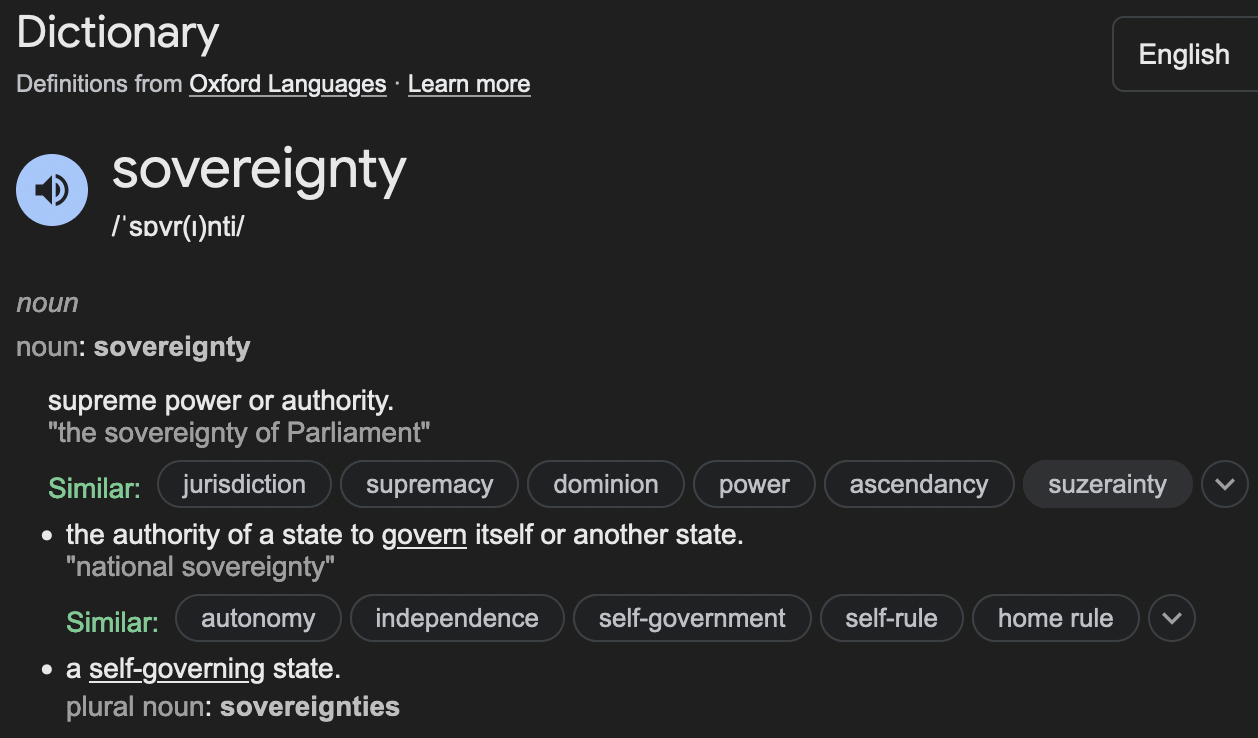The fever dream of 'technological sovereignty'

I recently came across an initiative called “Industrial47”. Someone had shared a link to it on a group I’m part of, and when its card loaded, the image was of a nuclear weapon going off.
I found on LinkedIn that “Industrial47” is a fund with the aim of “backing the forerunners of India’s Industrial Revolution”. I must say it’s quite dubious to read about a country-specific “industrial revolution” more than two centuries into a global post-industrial era. But maybe historical accuracy isn’t the point here so much as the josh elicited by those words. By this time, another member of the group had pointed out that all of India’s nuclear tests had been underground and that the one in the image depicts an American test.

Where technology meets people
According to its official website, Industrial47 currently funds companies developing technologies of the future. Why then did it have the image of a nuclear weapon going off? And why is there to be an Indian “industrial revolution”? *scrolls down the website* Here’s an answer — what looks like a mission statement. Let me annotate it.
We believe India’s moment is now.
Okay.
Our engineers aren’t just coding software anymore – they’re designing satellites, building robots, revolutionising agriculture, reimagining defence and rethinking energy.
There are five items listed here. The first two are factually accurate, the last two are unfalsifiable, and the third one is misleading. There’s no agricultural revolution. Let’s talk when it happens.
They’re tackling challenges that will define the next century of human progress.
Okay.
The problems we solve here will ripple across eons. The companies we build here will transform billions of lives.
The technologies we pioneer here will reshape what’s possible.
It’s not clear where “here” is, but okay. Also there’s a grammatical problem: “The problems we solve here will ripple across eons” seems to say the problems will ripple across eons, not the solutions.
This is more than a story of one nation’s rise. This is about humanity’s next giant leap.
…
When software meets steel, when code meets craft, when bits meet atoms – therein the future is forged.
And Industrial India will build out the next century.
See, now there’s a problem.
Since listening to a talk by Gita Chadha in 2020, I’ve been wary of the idea of “genius”. Among other things, I’ve noticed that there aren’t nearly as many “geniuses” in the social sciences and humanities as there are in the natural sciences. All these enterprises are littered with very difficult problems waiting to be solved but the idea of “genius” — as and when it is invoked — seems to apply only to those in the natural sciences. Even in the popular imagination, a “child prodigy” is expected to become a gifted mathematician or scientist, not a gifted poet or anthropologist. Great intellectual ability is preordained to be devoted to problems in science. Sometimes I amuse myself with the idea that problems in the social sciences and humanities simply overwhelm this “genius”.*
If the “future” of a country is to be “forged” at the moment “when software meets steel, when code meets craft, when bits meet atoms”, and without room for where technologies meet people — which technologies, which people, when, how — it sounds like a project that expects the socio-economic and the political pieces of the “future” to fall in place in accordance with the engineering goals alone.
You’re reading it wrong, you say. The fund only claims the future will also be forged in the solutions to engineering problems. We shouldn’t overlook these problems. I reply: Are you sure? Because I don’t see a fund to solve problems like increasing people’s trust in EVMs, changing the government’s mind on MRPs for farmers or ensuring machines, not people, clean sewers (and I mean everywhere and in practice, not just in isolated pilot projects). How about putting the best minds together to work on the problem of developing a socio-political ideology to ultimately restore a politics of dignity and common welfare? It’s nasty, arduous, wicked work but it’s also the ultimate challenge — one that, if it succeeds, would obviate the need for most of these other interventions. But if you’d rather begin with a specific one: did you know there still isn’t a smokeless stove for rural India’s millions, leaving the country the world’s largest consumer of fuelwood for household use? Here’s a summary of Shankar Nair’s pertinent comment in The Hindu in February 2023 by ChatGPT; I hope it encourages you to read the whole thing:
The launch of Indian Oil Corporation’s solar cook-stove at India Energy Week 2023 casts a harsh light on India’s ongoing efforts to transform household energy consumption. While promoted as a low-carbon innovation poised to reach three crore households and save costs, its steep price of ₹15,000 raises concerns about accessibility. This initiative echoes past efforts like the National Physical Laboratory’s solar cooker in the 1950s and the 1980s’ “improved chulhas” program, both of which failed due to poor design, high costs, and ineffective implementation despite government subsidies. The historical parallels underscore a recurring gap between state-led energy innovations and practical adoption, as well as the lack of focus on improving rural incomes, which strongly influence energy choices.
This post benefited from feedback from Srividya Tadepalli.
Social ignorance is social harm
Projects that offer new technological solutions these days to old problems almost never account for their social dimensions. They are instead left to the state. Isn’t this cynical? Last year’s controversy about using satellite data to track farm fires offers another good example — as does the overarching endeavour to stamp these fires out. When a new project starts up, it may advance the technology, have some companies make money, and they all move on. The socio-political and socio-economic needles almost never move. The problem of scale matters as well because of the financial implications inherent to the economic relationships between people and their technologies. At this stage of development, it is hard to give every new scheme and fund the benefit of the doubt when it ignores the question of minimising social harm and maximising social welfare. In fact, it seems like an expedient exclusion.**
Air-purifiers come to mind. Researchers have found links between air pollution on one hand and biological and psychological development on the other. (Update, 9.10 am on January 15, 2024: Nature has just published a news feature entitled 'Air pollution and brain damage: what the science says'.) In New Delhi (or any city with foul air for that matter), clean air is becoming increasingly vouchsafed for those with air-purifiers, which cost a good deal of money, require constant power supply, and of course owners that can pay these bills. The better and the more numerous the air-purifiers around you, the cleaner the air around you is, and the lower your risk of impaired biological and/or psychological development. Over time, people that can afford these living conditions — typically the “upper class” and, almost inevitably, “upper caste” lot — accumulate the benefits of clean air whereas those that can’t accumulate the ill-effects, and thus the gap between their fortunes slowly but inexorably widens. Every time the AQI crosses some headline-worthy threshold, New Delhi breaks out the “smog towers” and the “mist cannons” and home-appliance companies advertise newfangled air-conditioners and air-purifiers whereas state-led attempts to move towards a future in which no one needs air-purifiers flop. If I’m cynical to doubt initiatives like Industrial47, what would you call this?
Technologisation isn’t implicitly virtuous: to succeed in the fullest sense of improving the quality of life of all Indians, it needs specific social and political conditions as well. “1947 marked our political independence, 2047 will mark our technological sovereignty,” Rahul Seth, the person behind the Industrial47 fund and “an Infantry Officer with the Indian Army Reserves” with the rank of major, wrote in a LinkedIn post (whose card displayed the nuke test). His comment and its rapturous reception assume a clean break between political and technological achievement when in fact there’s no such thing.
Indeed, the comment is reminiscent of China’s rise as a “scientific superpower”. Part of this supposed achievement is founded on the slew of sophisticated and expensive scientific experiments it has executed, often in collaboration with other countries; its accelerating space programme; and its rapid industrialisation of the energy sector. The country is now planning to build the world’s largest hydroelectric-power dam on the Yarlung Tsangpo river, which becomes the Brahmaputra when it subsequently enters India. Until this new dam takes shape, China’s Three Gorges dam will continue to hold the torch of physical magnitude. I hope by now the dangers of building dams in the Himalaya should be clear enough to discourage unbridled enthusiasm for projects of this nature. This said, many have marvelled at the Three Gorges dam and what they claim it says about China’s ability to plan and execute such projects: as if flawlessly.
But the country’s surveillance and censorship apparatus hampers us from knowing how people on the ground suffered as they were forced to make way for the monstrous facility. Attesting to such concerns are anecdotes that have managed to escape plus informed scholarship (see here and here, for example). Frankly, I prefer the amount of friction local movements in India have brought to bear on new “development” projects in the country. Friction is good: it ensures project proponents think twice about what they’re doing if they already haven’t. And increasingly often, they haven’t, and why should they when the current national government seems to be doing its damnedest to dilute the friction? The LinkedIn post goes: “You can be the right person, in the right place, at the right time – and yet have a few key pieces missing. Leonardo da Vinci had Lorenzo de’ Medici. Walchand Hirachand had the Kingdom of Mysore. Chandragupta Maurya had Chanakya.”* To this I’d add: India once had friction, then squandered it.

When do we become scared?
The quip about “technological sovereignty” rankles in this regard. On any day ‘sovereignty’ is a powerful word, not one to be invoked in vain. Here, the term fantasises a future in which technology reigns supreme, but its framing also leaves open the question of India’s place in the comity of nations, which the country has worked hard to attain, continues to build on even today, and will for the foreseeable future. Recall that obnoxious piece on NASA Watch where a former JPL science-worker called NASA’s decision to downsize JPL’s workforce — due in part to budget overruns by the Mars Sample Return mission — the “fall of a civilisation”. It was reckless fear-mongering: among other things, NASA, and the US by extension, are currently more beneficiaries of an international collaboration than patrons of the spacefaring world. “In this milieu, harping on sole leadership because it’s the ‘American way’,” as the science-worker insisted it was, “is distasteful” (source). In the same vein, consider the example of ISRO’s forthcoming space station and Indian-on-the-moon plans. Its scientists and engineers are working hard but what are they working towards? Prime Minister Narendra Modi issued orders from on high to ISRO to build the ‘Bharatiya Antariksh Station’ by year X and land an Indian on the moon by year Y. And then what? We wait for the next diktat?
Imagine a future 50 years from now when it’s possible there are a few space stations in orbit around Earth and maybe even the moon, and when it’s plausibly (and relatively) more affordable, and not just in economic terms, to send people to stay and work there than to build a station of one’s own. Imagine if India owned and operated one of these stations instead of Indians having to lease time on another, you say. I reply: Sounds good, but where’s the cost-benefit analysis to this plan? Because unless you can demonstrate the benefit, we’re riding the coattails of speculation here and, importantly, you’re motivated by little more than the idea of Indian leadership rather than a proof of leadership de facto.
It’s reminiscent in turn of the International Conference on the Peaceful Uses of Atomic Energy in 1955: it was chaired by Homi Bhabha, a representative from India, then a country that didn’t have nuclear power of its own. Conferences are not countries, you say. And leadership doesn’t demand “steel”, “craft” or “atoms”, I reply. This is in fact what the comity of nations allows us: leadership in various forms, and freedom from the tunnel vision that condemns the country to just one. The aspiration to “technological sovereignty” rankles specifically because, taken together, it offers one pointless pinnacle at the expense of others, and without the requisite justification of its presumed supremacy.
The image of the nuclear weapon slips back into view. It’s from a promotional video in Seth’s LinkedIn post. It opens with a staccato montage of the Indian flag atop a temple tower, atop a mountain (Kargil?), atop the Red Fort, atop a glacier (Siachen?), and atop the moon.*** Perhaps the fund’s ultimate priority is national security, yet “technological sovereignty” implies even greater ambitions — as do other visuals in the video**** and the enterprises Industrial47 has already invested in. National security also exists today in a baleful avatar. Rather than inculcate something the armed forces deem worth fighting for, the government’s narratives have often attempted to cast soldiers’ “spirit and courage” themselves to be the objects of desire, the thing citizens at large must prove they deserve. The government has also invoked national security as a spectre, bolstered by periodic allegations of threats to Hindus, disinformation about the intentions of Muslims, and in general the communalisation of public life, to deny requests under the RTI Act about information as benign as the designs of scientific spacecraft. Unspecific appeals to national security have also become the basis for jailing students and academics for indefinite periods of time, expel foreign journalists, rebuke foreign governments’ comments on the country’s “internal affairs”, and deny the findings of international democracy and welfare research organisations. If this is national security, I sincerely dread a deeply technologised form.
It’s just a video, you say, and you’re seeing meaning that isn’t there. Most of you must’ve watched Oppenheimer by now but let me call your attention to something Leona Woods asked Enrico Fermi after the world’s first nuclear reactor went critical: “When do we become scared?” Call it the naïvety of eggheads or political premeditation, Oppenheimer et al. had control of the Bomb until suddenly they didn’t. Its very existence reshaped the world order. Whether or not it actually went off was secondary. This is scope creep: when the parameters of a project are changing so slowly as to not be threatening, until one day you realise they’ve crossed some threshold, an unforeseen tipping point, and significantly altered the scope of the project. You thought you had a hand on the wheel, and maybe you did, but the car’s almost imperceptible drift to the right now has you endangering oncoming traffic, and yourself, on the other lane. Call it pithy, call it a cliché, but science and the technologies that follow need a hand on the wheel to adjust the course of their fantasies every now and then instead of going with the flow. Politics needs your other hand on another wheel to do the same thing, considering science is already a reason of state in India. Otherwise, we’re left staring at “technological sovereignty”.
Or maybe these are all just words trading in josh on an investment fund’s webpage — although it does alert us to one particular plausibility and renders the words more potent: “The problems we solve here will ripple across eons. The companies we build here will transform billions of lives. The technologies we pioneer here will reshape what’s possible.” When do we become scared? I don’t know, but when you do, don’t ignore it. That’s all I’m asking.
* “Leonardo da Vinci had Lorenzo de’ Medici” and “Walchand Hirachand had the Kingdom of Mysore” — and of course a wider socio-political environment that they navigated as well, but this aside: notice the distinctive singularity of “genius”, its manifestation with problems amenable to being solved by individuals, often working alone, as was once the case in some of the sciences but hasn’t been so for more than a century — and as has more rarely been the case in the social sphere, virtually by definition.
** I can seem like a habitual naysayer but I assure you I’m not. I can’t get onboard with new technology + business ideas if they’re ill-conceived or if their social and political implications haven’t been thought through. If I keep saying ‘no’, it’s because I’m being met with a continuous stream of half-baked ideas. I have no obligation to put up with one every now and then.
*** The video includes footage from Associated Press. I hope it was licensed properly.
**** The video’s theme seems to be masculine middle-class fever dream. The scenes of its montage go space, space, sport, space, cricket, space, EV, sport, sport, a CEO, software code, sport, a CEO, a CEO, automation, an award, music, the stock market, Rajpath, military, Taj Mahal, IT, IT, a CEO, a CEO, space, space, mountains, tigers, IISc, IISc, metallurgy, military, Mahabharat on DD, space, some nuke test, polio vaccine, Shah Rukh Khan, Modi performing aarthi like a priest, AR Rahman, cricket, military, military, a CEO, automation, the “shayari jugalbandi” in Parliament, CV Raman, an Amul ad, military, that nuke test, military, military, Parle G biscuit dipped in tea, military, metallurgy, military, space, and finally Nehru hoisting the flag in front of a crowd of thousands.




